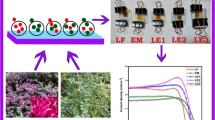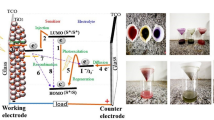Abstract
The domain of dye-sensitized solar cells, which use natural dye as a sensitizer, is still being studied. This work aims to determine the most potent sensitizers, namely Geneus Tectona grandis, Chassalia curviflora, and Lawsonia inermis for DSSC fabrication. These dyes were co-sensitized in equal proportions, and the performance of DSSCs was improved through co-sensitization of the natural dyes. The effect of sensitizers and their novel cocktail combination in various solvents namely ethanol and deionized water on DSSC performance is examined. Optical properties and the presence of anchoring groups (carboxyl and hydroxyl groups) in the dye extracts are revealed using UV–Vis and FTIR spectroscopy. Successful accomplishment in the conversion of sunlight into electricity and nano TiO2-based solar cells using Geneus Tectona grandis, Chassalia curviflora, Lawsonia inermis, and a cocktail of extracts in which Tectona grandis in ethanol displayed the highest photoconversion efficiency of 0.7% compared to co-sensitized dye extracts, whose power conversion efficiency is 0.2%, respectively. The presence of anthocyanin derivative in teak extracts is very sensitive to visible light and thus leads to higher photosensitized performance. Sensitizers for DSSCs must meet crucial parameters such as strong chelation to the semiconductor oxide surface and absorption in the visible and near-infrared portions of the solar spectrum.

















Similar content being viewed by others
Data availability
The datasets generated during and/or analyzed during the current study are available from the corresponding author upon reasonable request.
References
Ananth, S., Arumanayagam, T., Vivek, P., Murugakoothan, P.: Direct synthesis of natural dye mixed titanium dioxide nanoparticles by sol-gel method dye-sensitized solar cell applications. Optik 125, 495–498 (2014)
Boyle, G.: Power for a Sustainable Future. Renewable Energy, 2nd edn. Oxford University Press, Oxford, UK (2004)
Eli, D., Musa, G.P., Ezra, D.: Chlorophyll and betalain as light-harvesting pigments for nanostructured TiO2 based dye-sensitized solar cells. J. Energy Nat. Resour. 5(5), 53–58 (2016)
Hafez, H.S., Shenouda, S.S., Fadel, M.: Photovoltaic characteristics of natural light harvesting dye sensitized solar cells. Spectrochim. Acta Part A Mol. Biomol. Spectrosc. 192, 23–26 (2018)
Hamadanian, M., Safaei- Ghomi, J., Hosseinpour, M., Masoomi, R., Jabbari, V.: Uses of new natural dye photosensitizers in fabrication of high potential dye-sensitized solar cells (DSSCs). Mater. Sci. Semicond. Process. 27, 733–739 (2014)
Iqbal, M.Z., Ali, S.R., Khan, S.: Progress in dye sensitized solar cell by incorporating natural photosensitizers. Solar Energy 181, 490–509 (2019)
Kumara, N.T.R.N., Lim, A., Lim, C.M., Petra, M.I., Ekanayake, P.: Recent progress and utilization of natural pigments in dye sensitized solar cells: a review. Renew. Sustain. Energy Rev. 78, 301–317 (2017)
Maung, H.E., Theint, M.M., Lwin, N.W., Oo, T.Z.: Optical absorption and adsorption of natural dye extracts on TiO2 scaffolds: comparison between green leaf- and red fruit- extracts. J. Mater. Sci. Eng. 7, 166–170 (2017)
Maurya, I.C., Srivastava, P., Bahadur, L.: Dye-sensitized solar cell using extract from petals of male flowers Luffa cylindrica L. as a natural sensitizer. Opt. Mater. 52, 150–156 (2016)
Richhariya, G., Kumar, A., Tekasakul, P., Gupta, B.: Natural dyes for dye sensitized solar cell: a review. Renew. Sustain. Energy Rev. 69, 705–718 (2017)
Sathyajothi, S., Jayavel, R., Clara Dhanemozhi, A.: The fabrication of natural dye sensitized solar cell (DSSC) based TiO2 using henna and beetroot dye extracts. Mater. Today Proc. 4, 668–676 (2017)
Satria Arief, W. B., Yasuri, N., Sasongko, S. B., Widiyandari, H.: Effect of organic dye variation from teak leaves (Tectona grandis), tamarind leaves (Tamarindus indica) and daun ungu leaves (Graphtophyllum pictum) on dye-sensitized solar cell (DSSC) performance
Shalini, S., Prasanna, S., Mallick, T.K., Senthilarasu, S.: Review on natural dye sensitized solar cells: operation, materials and methods. Renew. Sustain. Energy Rev. 51, 1306–1325 (2015)
Syafinar, R., Gomesh, N., Irwanto, M., Fareq, M., Irwan, Y.M.: Chlorophyll pigments as nature based dye for dye-sensitized solar cell (DSSC). Energy Proc. 79, 896–902 (2015)
Timothy C. Coburn, Barbara C, Farhar. Renewable Energy: An Overview (2001)
Vyas, P., Yadav, D.K., Khandelwal, P.: Tectona grandis (teak)—a review on its phytochemical and therapeutic potential. Nat. Prod. Res. 33(16), 2338–2354 (2019)
Author information
Authors and Affiliations
Contributions
PP: Conceptualization; Investigation; Data curation; Formal analysis; Writing—original draft. NR: Investigation; Resources. SS: Investigation; Resources. BJ: Validation; Supervision.
Corresponding author
Ethics declarations
Conflict of interest
None to declare.
Additional information
Publisher's Note
Springer Nature remains neutral with regard to jurisdictional claims in published maps and institutional affiliations.
Rights and permissions
Springer Nature or its licensor holds exclusive rights to this article under a publishing agreement with the author(s) or other rightsholder(s); author self-archiving of the accepted manuscript version of this article is solely governed by the terms of such publishing agreement and applicable law.
About this article
Cite this article
Prakash, P., Ruba, N., Sowmya, S. et al. A novel approach to dye-sensitized solar cells using natural cocktail photosensitizers with nano TiO2 semiconductor. Opt Quant Electron 54, 843 (2022). https://doi.org/10.1007/s11082-022-04242-1
Received:
Accepted:
Published:
DOI: https://doi.org/10.1007/s11082-022-04242-1




